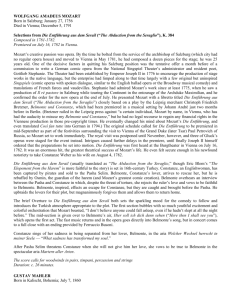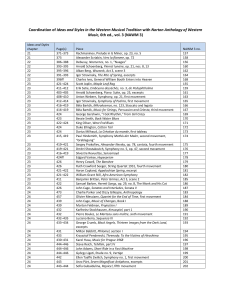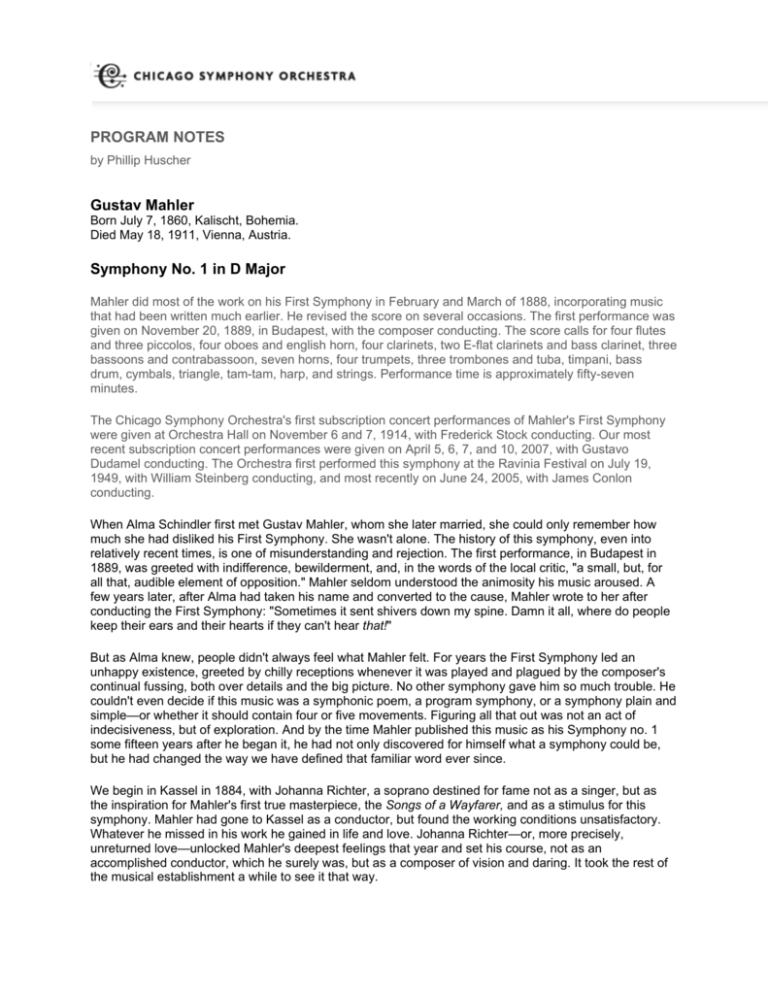
PROGRAM NOTES
by Phillip Huscher
Gustav Mahler
Born July 7, 1860, Kalischt, Bohemia.
Died May 18, 1911, Vienna, Austria.
Symphony No. 1 in D Major
Mahler did most of the work on his First Symphony in February and March of 1888, incorporating music
that had been written much earlier. He revised the score on several occasions. The first performance was
given on November 20, 1889, in Budapest, with the composer conducting. The score calls for four flutes
and three piccolos, four oboes and english horn, four clarinets, two E-flat clarinets and bass clarinet, three
bassoons and contrabassoon, seven horns, four trumpets, three trombones and tuba, timpani, bass
drum, cymbals, triangle, tam-tam, harp, and strings. Performance time is approximately fifty-seven
minutes.
The Chicago Symphony Orchestra's first subscription concert performances of Mahler's First Symphony
were given at Orchestra Hall on November 6 and 7, 1914, with Frederick Stock conducting. Our most
recent subscription concert performances were given on April 5, 6, 7, and 10, 2007, with Gustavo
Dudamel conducting. The Orchestra first performed this symphony at the Ravinia Festival on July 19,
1949, with William Steinberg conducting, and most recently on June 24, 2005, with James Conlon
conducting.
When Alma Schindler first met Gustav Mahler, whom she later married, she could only remember how
much she had disliked his First Symphony. She wasn't alone. The history of this symphony, even into
relatively recent times, is one of misunderstanding and rejection. The first performance, in Budapest in
1889, was greeted with indifference, bewilderment, and, in the words of the local critic, "a small, but, for
all that, audible element of opposition." Mahler seldom understood the animosity his music aroused. A
few years later, after Alma had taken his name and converted to the cause, Mahler wrote to her after
conducting the First Symphony: "Sometimes it sent shivers down my spine. Damn it all, where do people
keep their ears and their hearts if they can't hear that!"
But as Alma knew, people didn't always feel what Mahler felt. For years the First Symphony led an
unhappy existence, greeted by chilly receptions whenever it was played and plagued by the composer's
continual fussing, both over details and the big picture. No other symphony gave him so much trouble. He
couldn't even decide if this music was a symphonic poem, a program symphony, or a symphony plain and
simple—or whether it should contain four or five movements. Figuring all that out was not an act of
indecisiveness, but of exploration. And by the time Mahler published this music as his Symphony no. 1
some fifteen years after he began it, he had not only discovered for himself what a symphony could be,
but he had changed the way we have defined that familiar word ever since.
We begin in Kassel in 1884, with Johanna Richter, a soprano destined for fame not as a singer, but as
the inspiration for Mahler's first true masterpiece, the Songs of a Wayfarer, and as a stimulus for this
symphony. Mahler had gone to Kassel as a conductor, but found the working conditions unsatisfactory.
Whatever he missed in his work he gained in life and love. Johanna Richter—or, more precisely,
unreturned love—unlocked Mahler's deepest feelings that year and set his course, not as an
accomplished conductor, which he surely was, but as a composer of vision and daring. It took the rest of
the musical establishment a while to see it that way.
Mahler followed an unorthodox path in getting from Johanna Richter to his First Symphony, but it's one he
would choose again and again when writing music, and it's the process as much as the composer himself
that gives Mahler's symphonies their unconventional stamp. Henry James once described a novelist as
someone on whom nothing is lost. For Mahler, that defined a symphonist. The First Symphony is
indebted, in various ways, to Johanna Richter, the Wayfarer songs, incidental music Mahler wrote for a
production of Joseph Victor von Scheffel's Der Trompeter von Säkkingen, a familiar children's round, the
wife of Carl Maria von Weber's grandson, yodeling, military fanfares, an early nineteenth-century
woodcut, café music, the opening of Beethoven's Ninth Symphony, bird song at dawn, a love song he
wrote in 1880, reveille, the German ländler—and sights, sounds, and feelings we will never know. Since
Mahler hadn't written a large, purely orchestral work before, it took him some time to find the right way to
bring all his resources together and to make a convincing whole of so many parts. In the meantime, life
presented new choices, and love was reawakened by Marion von Weber, the wife of the composer's
grandson.
The piece Mahler introduced in Budapest on November 20, 1889, was billed as a "Symphonic Poem in
two parts"—with three movements in part 1 and two in part 2. Only the funeral march was labeled to help
listeners coming to the music cold. Today it's easy to see that it wasn't the lack of labels or comments, but
simply the staggering range and provocative juxtaposition of materials that bothered the first audience.
For the next performances, in Hamburg and Weimar (in 1893 and 1894), Mahler drew up a descriptive
program, gave titles to the movements, and called the whole piece "Titan, a tone poem in symphonic
form," after the popular novel by Jean Paul. For Berlin in 1896, Mahler again changed his mind, dropped
the titles and the programmatic explanation, omitted the second movement (Blumine), and settled on
"Symphony in D major, for large orchestra." (The Blumine movement, originally part of the incidental
music he wrote for a staging of Scheffel's narrative poem Der Trompeter von Säkkingen, was
subsequently lost. In 1959 a score of the movement turned up at a Sotheby's auction; it was performed in
1967 for the first time since Mahler's death.) In Vienna in 1900, a notice in the program indicated that
Mahler wanted no explanatory notes of any kind. Why such indecision? In March 1896, at the time of the
Berlin performance, Mahler wrote to the critic Max Marschalk about adding the program in the first place:
. . . At the time my friends persuaded me to provide a kind of program for the D major
symphony in order to make it easier to understand. Therefore, I had thought up this title
and explanatory material after the actual composition. I left them out for this performance,
not only because I think they are quite inadequate and do not even characterize the
music accurately, but also because I have learned through past experiences how the
public has been misled by them.
Still, Mahler's First Symphony wasn't understood. Critics in Frankfurt complained about the program,
those in Berlin missed it. (At this same time, Strauss was writing Till Eulenspiegel, Also sprach
Zarathustra, and Ein Heldenleben, which begged the same questions.) Even though Mahler finally
decided to present this symphony as abstract music with no story to tell, he wrestled with the same
dilemma again in writing symphonies nos. 2 and 3 and came to slightly different conclusions each time.
Mahler's final thoughts on this music were published in 1899 as Symphony no. 1, in four movements, and
that's how it's known today.
The first movement begins "like a sound of nature," with fanfares and bird calls sounding from the
distance over the gentle hum of the universe, tuned to A-natural and scattered over seven octaves. The
method is one learned by every composer since Beethoven, whose Ninth Symphony opens with bits and
pieces that gradually become music. It took Mahler a long time to get the opening to sound the way he
wanted it; every effect is precisely calculated, with consideration given not only to the most delicate
shades of dynamics, but to the placement of the players on and off the stage.
A cuckoo—unlike Beethoven's cuckoo in the Pastoral Symphony, it sings the interval of a fourth instead
of a third—eventually pushes the sounds of nature into a lovely, rolling melody. That tune, beginning with
the cuckoo's descending fourth, comes from the second Wayfarer song, "Ging heut' Morgen übers Feld"
(I went through the fields this morning), and its proud walking music takes Mahler a long way. Mahler
reinvents the song as he goes, reshuffling phrases and motives so that even someone who knows the
song finds this music continually fresh.
Next comes a brief scherzo set in motion by the foot-stomping dances and yodeling that Mahler heard
and had already put to good use in one of his first songs, "Hans und Grete," in 1880. "Dance around,
around!" the song goes. "Let whoever is happy weave in and out! Let whoever has cares find his way
home." There is a wistful trio, music Mahler might have heard in a Viennese café, more full of cares than
joy, and then the ländler resumes.
The third movement used to upset audiences, and even today it's puzzling to those hearing it for the first
time. What are we to make of this odd assortment: a sad and distorted version of "Frère Jacques" (Mahler
knew it as "Bruder Martin"); a lumbering funeral march; some cheap dance-band music remembered by
pairs of oboes and trumpets over the beat of the bass drum; and the ethereal closing pages of the
Wayfarer songs—heaven and earth all rolled into one? No wonder people didn't know whether to laugh or
cry. Mahler's only clue is "The Hunter's Funeral Procession"—a woodcut made earlier in the century by
Moritz von Schwind, a friend of Schubert—which he claimed was the inspiration for this music. About the
vulgar band music Mahler leaves no doubt: "With parody" he writes at the top of the page, just as the
drum and cymbal join in. (A note: At this performance, the famous "Frère Jacques" theme that opens the
movement, traditionally given to muted solo double bass, is played by the entire section, muted. This is a
rereading of Mahler's intentions, which have long been misunderstood. Although Mahler experimented
with this passage for several years in order to get the effect he had in mind, he apparently settled on the
idea of having all the double basses play this haunting "solo" in unison, only to discover that this was
beyond the capability of most orchestral bass sections. Giving it to the principal player alone was an
expedient compromise at the time that has erroneously become a convention. Bernard Haitink is the first
conductor of the Chicago Symphony to have the full bass section play this passage.)
The finale begins with a "flash of lightning from a dark cloud," Mahler tells us. "It is simply the cry of a
wounded heart." This is music in search of victory, and Mahler retreats from battle several times before
he triumphs. The first stop allows us to savor some lovely pastoral music we would recognize if Mahler
hadn't ultimately chosen to omit his original second movement, Blumine. Later we return to the fields of
the first movement, but we're no longer setting off on our journey—we're headed straight for the triumph
that Mahler's wayfarer couldn't achieve. This time success is swift and unequivocal, and when the seven
horns are asked to play out—"even over the trumpets"—victory is won.
The Chicago Symphony recorded Mahler's First Symphony in 1971 under Carlo Maria Giulini for Angel, in
1981 under Claudio Abbado for Deutsche Grammophon, in 1983 under Sir Georg Solti for London, in
1990 under Klaus Tennstedt for EMI, and in 1998 under Pierre Boulez for Deutsche Grammophon.
Phillip Huscher is the program annotator for the Chicago Symphony Orchestra.
© Chicago Symphony Orchestra. All rights reserved. Program notes may be reproduced only in their
entirety and with express written permission from the Chicago Symphony Orchestra.
These notes appear in galley files and may contain typographical or other errors. Programs subject to
change without notice.


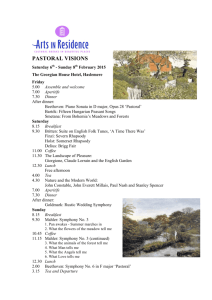
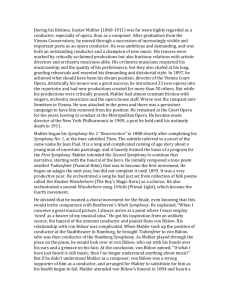
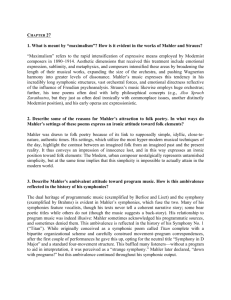
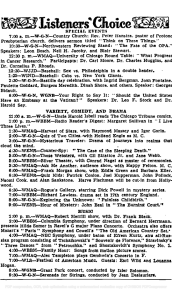
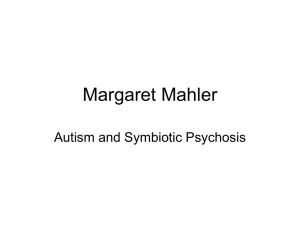
![[357] NOTES (ANMERKUNGEN)[1] Gustav Mahler was born on July](http://s3.studylib.net/store/data/007546861_2-0633dcb1969ca51a81f00783c5c4bd68-300x300.png)
